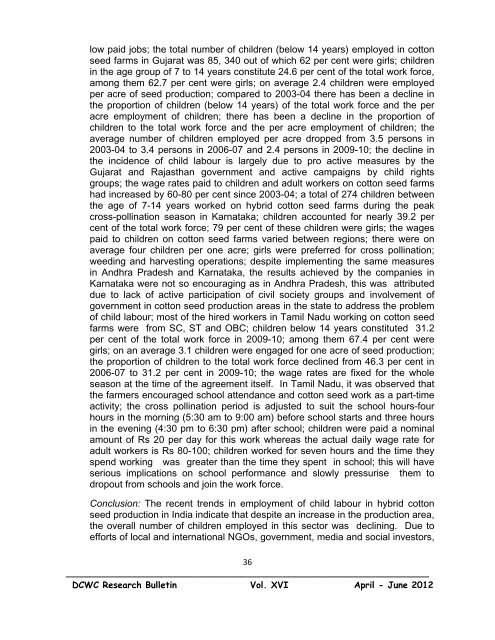Vol. XVI Issue 2 April - June 2012 2012 Documentation ... - Nipccd
Vol. XVI Issue 2 April - June 2012 2012 Documentation ... - Nipccd
Vol. XVI Issue 2 April - June 2012 2012 Documentation ... - Nipccd
Create successful ePaper yourself
Turn your PDF publications into a flip-book with our unique Google optimized e-Paper software.
low paid jobs; the total number of children (below 14 years) employed in cotton<br />
seed farms in Gujarat was 85, 340 out of which 62 per cent were girls; children<br />
in the age group of 7 to 14 years constitute 24.6 per cent of the total work force,<br />
among them 62.7 per cent were girls; on average 2.4 children were employed<br />
per acre of seed production; compared to 2003-04 there has been a decline in<br />
the proportion of children (below 14 years) of the total work force and the per<br />
acre employment of children; there has been a decline in the proportion of<br />
children to the total work force and the per acre employment of children; the<br />
average number of children employed per acre dropped from 3.5 persons in<br />
2003-04 to 3.4 persons in 2006-07 and 2.4 persons in 2009-10; the decline in<br />
the incidence of child labour is largely due to pro active measures by the<br />
Gujarat and Rajasthan government and active campaigns by child rights<br />
groups; the wage rates paid to children and adult workers on cotton seed farms<br />
had increased by 60-80 per cent since 2003-04; a total of 274 children between<br />
the age of 7-14 years worked on hybrid cotton seed farms during the peak<br />
cross-pollination season in Karnataka; children accounted for nearly 39.2 per<br />
cent of the total work force; 79 per cent of these children were girls; the wages<br />
paid to children on cotton seed farms varied between regions; there were on<br />
average four children per one acre; girls were preferred for cross pollination;<br />
weeding and harvesting operations; despite implementing the same measures<br />
in Andhra Pradesh and Karnataka, the results achieved by the companies in<br />
Karnataka were not so encouraging as in Andhra Pradesh, this was attributed<br />
due to lack of active participation of civil society groups and involvement of<br />
government in cotton seed production areas in the state to address the problem<br />
of child labour; most of the hired workers in Tamil Nadu working on cotton seed<br />
farms were from SC, ST and OBC; children below 14 years constituted 31.2<br />
per cent of the total work force in 2009-10; among them 67.4 per cent were<br />
girls; on an average 3.1 children were engaged for one acre of seed production;<br />
the proportion of children to the total work force declined from 46.3 per cent in<br />
2006-07 to 31.2 per cent in 2009-10; the wage rates are fixed for the whole<br />
season at the time of the agreement itself. In Tamil Nadu, it was observed that<br />
the farmers encouraged school attendance and cotton seed work as a part-time<br />
activity; the cross pollination period is adjusted to suit the school hours-four<br />
hours in the morning (5:30 am to 9:00 am) before school starts and three hours<br />
in the evening (4:30 pm to 6:30 pm) after school; children were paid a nominal<br />
amount of Rs 20 per day for this work whereas the actual daily wage rate for<br />
adult workers is Rs 80-100; children worked for seven hours and the time they<br />
spend working was greater than the time they spent in school; this will have<br />
serious implications on school performance and slowly pressurise them to<br />
dropout from schools and join the work force.<br />
Conclusion: The recent trends in employment of child labour in hybrid cotton<br />
seed production in India indicate that despite an increase in the production area,<br />
the overall number of children employed in this sector was declining. Due to<br />
efforts of local and international NGOs, government, media and social investors,<br />
36<br />
__________________________________________________________________________________<br />
DCWC Research Bulletin <strong>Vol</strong>. <strong>XVI</strong> <strong>April</strong> - <strong>June</strong> <strong>2012</strong>

















